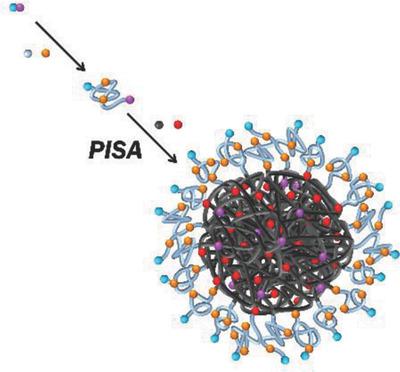当前位置:
X-MOL 学术
›
Macromol. Rapid Commun.
›
论文详情
Our official English website, www.x-mol.net, welcomes your
feedback! (Note: you will need to create a separate account there.)
Reactive and Functional Nanoobjects by Polymerization‐Induced Self‐Assembly
Macromolecular Rapid Communications ( IF 4.2 ) Pub Date : 2018-10-16 , DOI: 10.1002/marc.201800551 Dao Le 1, 2 , Dominic Keller 1, 2 , Guillaume Delaittre 1, 2
Macromolecular Rapid Communications ( IF 4.2 ) Pub Date : 2018-10-16 , DOI: 10.1002/marc.201800551 Dao Le 1, 2 , Dominic Keller 1, 2 , Guillaume Delaittre 1, 2
Affiliation

|
Polymerization‐induced self‐assembly (PISA) is becoming a standard technique for generating core–shell polymeric nanoparticles of various morphologies ranging from classic spheres to rods/fibers (“worm‐like”) and vesicles. After the initial quest for polymerization control in dispersed media, the focus of PISA research has drastically shifted, first to morphological control and now to the introduction of reactivity and functionality in order to generate useful materials. The present review is dedicated to the latter aspect. Reactivity is distinguished from functionality such as complexing, templating, and catalyzing. Approaches for either shell or core functionalization are also detailed separately.
中文翻译:

聚合诱导的自组装反应性和功能性纳米物体
聚合诱导的自组装(PISA)正在成为一种标准技术,用于生成从经典球体到棒/纤维(“蠕虫状”)和囊泡等各种形态的核-壳型聚合物纳米颗粒。在最初寻求在分散介质中进行聚合控制之后,PISA的研究重点已发生了重大转变,首先是形态控制,现在是引入反应性和功能性以产生有用的材料。本评论致力于后一个方面。反应性不同于诸如络合,模板化和催化之类的功能。Shell或内核功能化的方法也分别进行了详细说明。
更新日期:2018-10-16
中文翻译:

聚合诱导的自组装反应性和功能性纳米物体
聚合诱导的自组装(PISA)正在成为一种标准技术,用于生成从经典球体到棒/纤维(“蠕虫状”)和囊泡等各种形态的核-壳型聚合物纳米颗粒。在最初寻求在分散介质中进行聚合控制之后,PISA的研究重点已发生了重大转变,首先是形态控制,现在是引入反应性和功能性以产生有用的材料。本评论致力于后一个方面。反应性不同于诸如络合,模板化和催化之类的功能。Shell或内核功能化的方法也分别进行了详细说明。











































 京公网安备 11010802027423号
京公网安备 11010802027423号